Principles, methods and ways of the organization of emergency lighting
Quantitative and quality standards are expressed in the following figures:
The minimum horizontal illumination at the level pola:1 luxury;
Maximum uniformity of illumination of Emax: Emin ≤ 40: 1;
Color rendition index: Ra ≥ 40;
Nominal holding time for ways of evacuation: 1 hour;
Delay on inclusion: 50% of necessary level within 5 seconds, 100% within 60 seconds.
Artificial lighting is subdivided on working, emergency, security and on duty. If necessary the part of lamps of working or emergency light can be used for emergency lighting.
The working light is intended for normal illumination on workplaces.
Emergency lighting provides the demanded normalized illumination at sudden shutdown of a working light.
Emergency lighting is divided into illumination of safety and evacuation.
Illumination of safety should be provided in cases if shutdown of a working light and the violation of service of the equipment and mechanisms connected with it can cause:
explosion, fire, poisoning of people;
long violation of technological process;
violation of work of such objects as power plants, knots of radio - both telecasts, and communication, control
offices, pump installations of water supply, the sewerage and central heating, installation of ventilation and
air conditioning for production rooms in which cessation of work, etc. is inadmissible;
violation of the mode of child care facilities irrespective of number of the children who are in them.
Evacuation lighting in rooms or out of buildings should be provided in places of production of works:
in the places dangerous to pass of people;
in passes and on the ladders serving for evacuation of people, at number of the evacuated more than 50 people;
on the main passes of production rooms in which more than 50 people works;
in staircases of residential buildings 6 floors high and more;
in production placements with the people who are constantly working to them where the exit of people from the room at an emergency shutdown of normal lighting is connected with danger of traumatism because of further work of the production equipment;
in rooms of public and auxiliary buildings of the industrial enterprises. if in rooms there can be at the same time more than 100 people;
in production rooms without natural light.
Illumination of safety has to create on working surfaces in production rooms and in territories of the enterprises demanding service at shutdown of a working light, the smallest illumination of 5% of the illumination normalized for a working light from the general lighting, but not less than 2 lx in buildings and not less than 1 lx for territories of the enterprises. Thus to create the smallest illumination in buildings more than 30 lx at digit lamps and more than 10 lx at glow lamps it is allowed only in the presence of the corresponding justifications.
Evacuation lighting has to provide the smallest illumination on a floor of the main passes (or on the earth) and at steps of ladders: in rooms — 0,5 lx, in open territories — 0,2 lx.
Unevenness of evacuation lighting (the relation of the maximum illumination to minimum) on an axis of evacuation passes has to be no more than 40: 1.
Lamps of illumination of safety in rooms can be used for evacuation lighting.
In public and auxiliary buildings of the enterprises exits from rooms where there can be at the same time more than 100 people, and also exits from production rooms without natural light where there can be at the same time more than 50 people or having the area more than 150 sq.m, have to be noted by indexes.
Indexes of exits can be light, with the light sources which are built in them attached to a network of emergency lighting and not light (without light sources) provided that designation of an exit (an inscription, a sign, etc.) is lit with lamps of emergency lighting.
Thus indexes have to be established at distance no more than 25 m from each other, and also in places of turn of a corridor. Exits from the corridors and recreations adjoining the rooms which are listed above have to be in addition noted by indexes.
Light devices of emergency lighting (illumination of safety, evacuation) it is allowed to provide burning, included along with the main illuminants of normal lighting and not burning, automatically included at the termination of food of a working light.
Lamps for emergency lighting can have integrated, or the external emergency block and the battery for food of a light source at the time of power off of a working light.
More effective is the way of an exception of emergency light sources of structure of lamps of a working light and connection them to the independent power supply.
In a concrete case in lighting calculations the following basic data were used:
Room height on zones: 6, 4 meters
Basis surface: 4103 sq.m
Operating factor: 0,8
Reflection coefficient: floors – 63%, ceiling – 70%, a wall – 11 and 68%
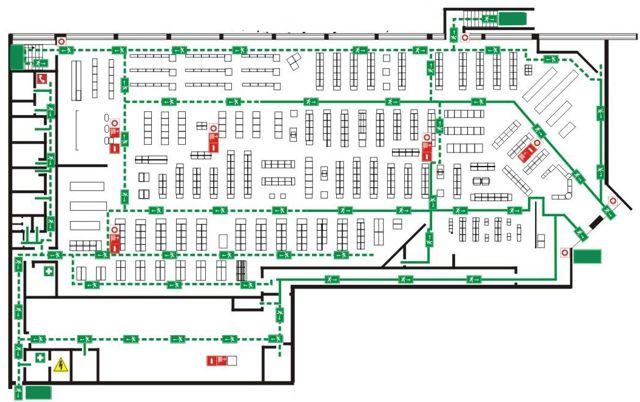
At calculation of ways of evacuation for the provided plan the following requirements were considered:
Ways of evacuation on width to 2 m: at least 1 lx along the central axis; at least 0,5 lx, on a half of width
Measurements are taken 2 cm above a floor; only direct light from emergency light sources was considered.
floors – 63%, ceiling – 70%, a wall – 11 and 68%
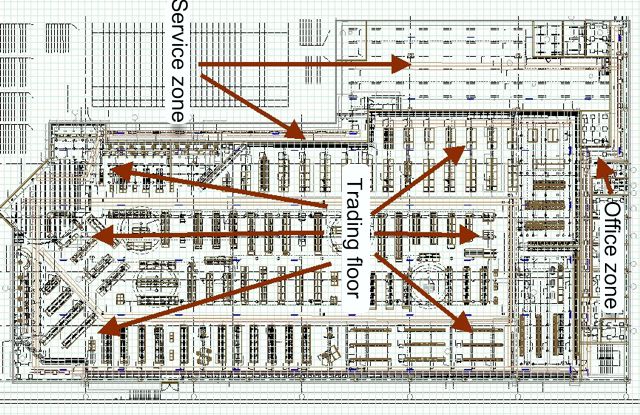
At implementation of the project three options of the organization of emergency lighting with the integrated and external emergency blocks and batteries, and also possibility of connection to the independent power supply are considered:
Option 1 - Integrated emergency blocks and batteries.
Illuminant lamp of emergency lighting of the LT EML series
Lighting results:
Number of lamps: 93 pieces
Connected power: 1774 W
Average illumination: 2,86 lx
Uniformity on the working plane Emin / Ecp: 0.102 (1:10)
Emin/Emax: 0.038 (1:26)
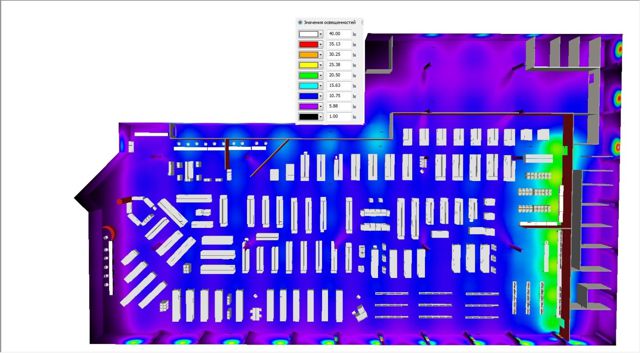
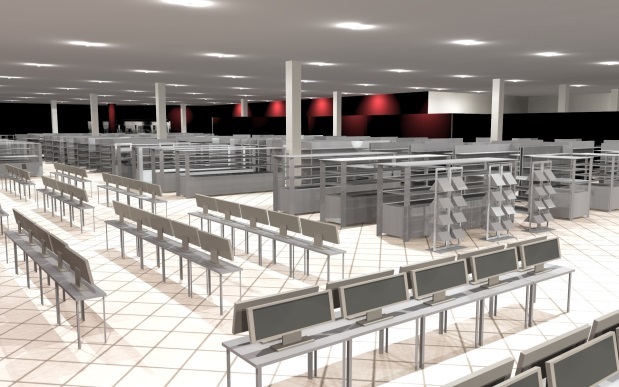
Option 2 - Connection of emergency light sources to the independent power supply.
Illuminant LED SSP-1
Emergency block:
System unit BS 1-220/2-1 (2 groups, 2 KW, emergency operation 1 hour) VRLA Battery of 18 pieces x 12 V
Lighting results:
Number of lamps: 84 pieces
Connected power: 806 W
Average illumination: 9,99 lx
Uniformity on the working plane Emin/Ecp: 0.103 (1:10)
Emin/Emax: 0.033 (1:31)
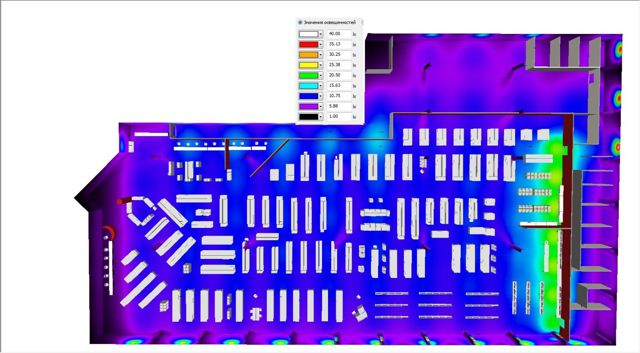
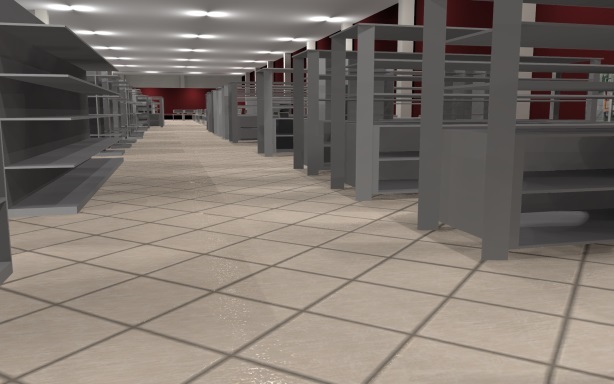
Option 3 External emergency blocks and batteries.
Illuminant lamp of emergency lighting of BAP
Lighting results:
Number of lamps: 69 pieces
Connected power: 1,1 kW
Average illumination: 33 lx
Uniformity on the working plane Emin/Ecp: 0.087 (1:12)
Emin/Emax: 0.023 (1:43)
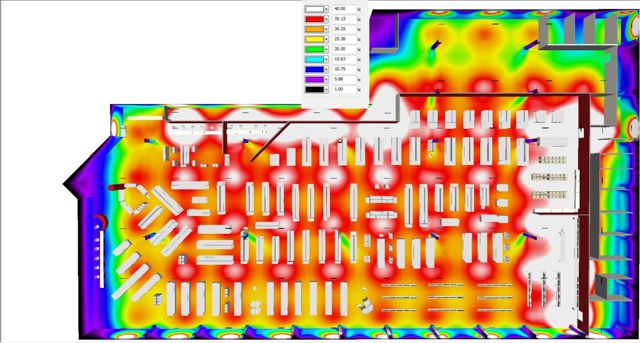
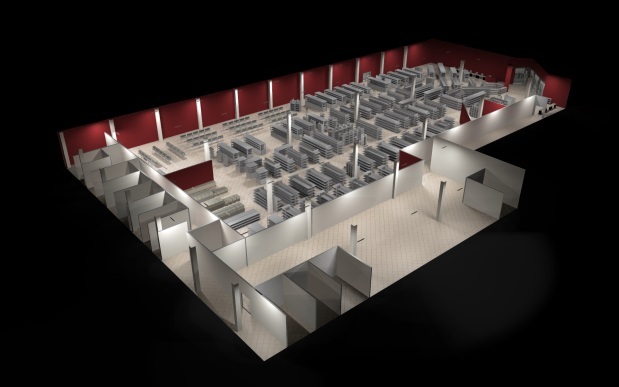
Recommendations:
Considering merits and demerits of each of the offered schemes, we offer in practice to use connection of emergency light sources to the independent power supply that will allow:
To connect the small power (exchange of 1 kW);
To provide the admissible level of illumination and unevenness of evacuation lighting within 1:40;
Possibility of group and address testing of lamps.
Connection of all emergency light sources to a uniform element of management (emergency block).